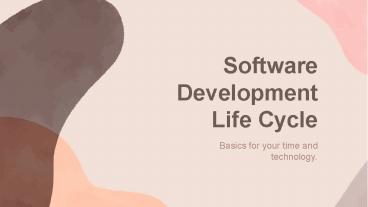Software Development Life Cycle - PowerPoint PPT Presentation
Title:
Software Development Life Cycle
Description:
Software development is fascinating. It always is interesting to find out the new innovations and ideas that you can execute and bring those ideas to life. Not every one is made for this. Not every one loves it. Passionate and a very few people who are interested paves the highway with success. – PowerPoint PPT presentation
Number of Views:148
Title: Software Development Life Cycle
1
Software Development Life Cycle
- Basics for your time and technology.
2
Software Development Life Cycle
Software development is fascinating. It always is
interesting to find out the new innovations and
ideas that you can execute and bring those ideas
to life. Not every one is made for this. Not
every one loves it. Passionate and a very few
people who are interested paves the highway with
success. But as there are a lot of demands coming
out of nowhere now a day because of the
unavailability of physical stores and offices or
work places, people tend to become a software
developer. Although a very few know about the
software development life cycle. But as the pay
is quite attractive, people focus on the money
rather than the information about the software
development. And this is not only the case of an
individual but also people who work in a software
development company fails to attain basics.
3
Life Cycle
Planning
Analysis and requirements
Development
Integration Testing
Design
Operations maintenance
Implementation
4
Planning
- This is the first phase in the software
development. It identifies whether or not there
is the need for a new software to achieve a
businesss foreseen objectives. This is a
preliminary planning (or a feasibility
study-tour) for a companys business initiative
to acquire the resources to build on an
infrastructure to modify or improve a service.
The organization may be attempting to meet or
surpass assumptions for their representatives,
clients and partners as well.
5
Analysis and requirements
- The subsequent stage is the place where
organizations will deal with the concern or the
requirement for a change. In case of an issue,
potential arrangements are submitted and
dissected to distinguish the best fit for a
definitive goal(s) of the task. This is the place
where groups think about the practical
prerequisites of the project or arrangement. It
is likewise where framework examination
happensor dissecting the requirements of the
end-clients to guarantee the new framework can
live up to their desires. Frameworks
investigation is crucial in figuring out what a
business's needs are, also as how they can be
met, who will be liable for individual bits of
the task, and what kind of timetable ought to be.
6
Design
- The third level depicts, in detail, the vital
specs, features, and tasks that will fulfill the
functional requirements of the proposed framework
which will be set up. This is the stage for
end-clients to talk about and decide their
particular business data needs for the proposed
framework. It's during this stage that they will
think about the fundamental segments (software
and hardware) structure (networking capacities),
and methods for the framework to achieve its
targets. The main elements tends to remain the
UI/UX that must be fabricated and selected for
the project.
7
Development
- The fourth stage is the point at which the
genuine work startsspecifically, when a software
developer, database developer, and additionally
data set designer are welcomed on to accomplish
the significant work on the task. This work
incorporates utilizing a stream diagram to
guarantee that the cycle of the framework is
appropriately coordinated. The improvement stage
denotes the finish of the underlying part of the
interaction. Also, this stage connotes the
beginning of creation.
8
Integration and Testing
- The fifth stage includes system integration and
framework testing (of projects and systems)
regularly did by a Quality Assurance (QA)
proficientto decide whether the proposed
configuration meets the underlying arrangement of
business objectives. Testing might be repeated,
explicitly to check for blunders, bugs, and
interoperability. This testing will be performed
until the end-client thinks that its adequate.
Another piece of this stage is check and
approval, the two of which will help guarantee
the programs fruitful finishing.
9
Implementation
- The 6th stage is the point at which most of the
coding for the program is composed. Also, this
stage includes the real establishment of the
recently evolved framework. This progression
places the task into creation by moving the
information and segments from the old framework
and setting them in the new framework by means of
a direct cutover. While this can be a risky (and
complicated) move, the cutover normally occurs
during off-peak hours, subsequently limiting the
danger. Both framework analysts and end-users
should now see the acknowledgment of the task
that has carried out changes.
10
Operations and maintenance
- The seventh and final phase involves maintenance
and regular required updates. This step is when
end users can fine-tune the system, if they wish,
to boost performance, add new capabilities or
meet additional user requirements.
11
Thank You.

